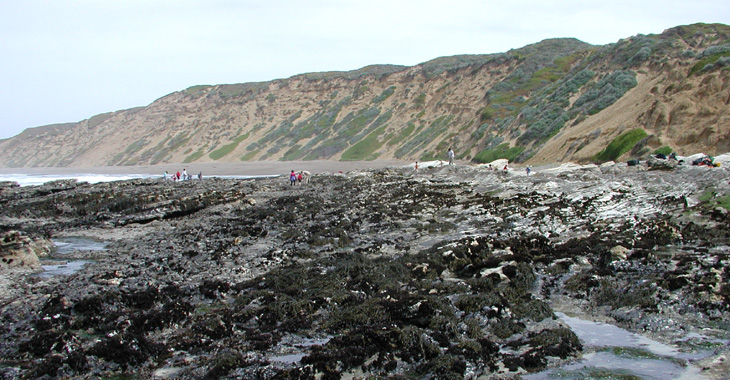Hazards | MARINe
Click here for Long-Term trends
Click here for Biodiversity Survey findings
Hazards is located in the Central Coast region of California, within Montaña de Oro State Park. This site is near the Morro Bay/Virg's Mussel Watch site. Visitation by tidepoolers and surfers at this park is fairly high. This gently sloping site consists of moderately uneven terrain, containing few cracks and folds.

Hazards is dominated by consolidated bedrock, and the area surrounding the site is comprised of a mixture of consolidated bedrock, boulder fields, and sandy beach. The primary coastal orientation of this site is northwest.
Long-Term Monitoring Surveys at Hazards were established in 1995, and are done by University of California Santa Cruz. Long-Term MARINe surveys currently target the following species: Chthamalus/Balanus (Acorn Barnacles), Mytilus (California Mussel), Silvetia (Golden Rockweed), Endocladia (Turfweed), Mazzaella (Iridescent Weed), Phyllospadix (Surfgrass), and Pisaster (Ochre Star). In addition, motile invertebrates, barnacle recruitment, mussel size structure, and water temperature are monitored at this site. Click here to view Long-Term trends at this site.
Biodiversity Surveys were done in 2001, 2005, 2017, and 2022. The Biodiversity Survey grid encompasses two sections that are approximately 12 meters (along shore) x 50 meters (seaward), and 14.5 meters (along shore) x 50 meters (seaward). Click here to view Biodiversity Survey findings at this site.
Voucher specimens of selected invertebrate and seaweed species were collected from this site by California State University Fullerton in 2016. The MARINe vouchering effort was designed to collect and archive samples of species that are monitored using MARINe protocols. Archived samples from this site at the Smithsonian Institution (invertebrates) and University of California Berkeley Herbarium (algae) are identified as BOEM-MARINE-HAZ-111716.
For more information about Hazards, please contact Pete Raimondi (raimondi@ucsc.edu).


